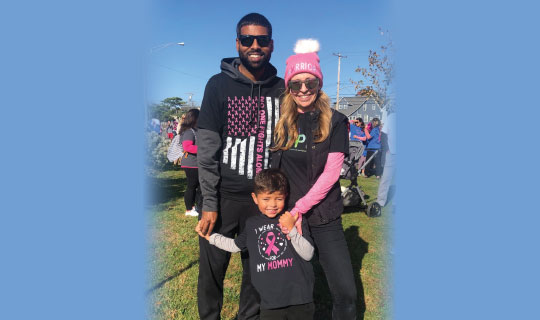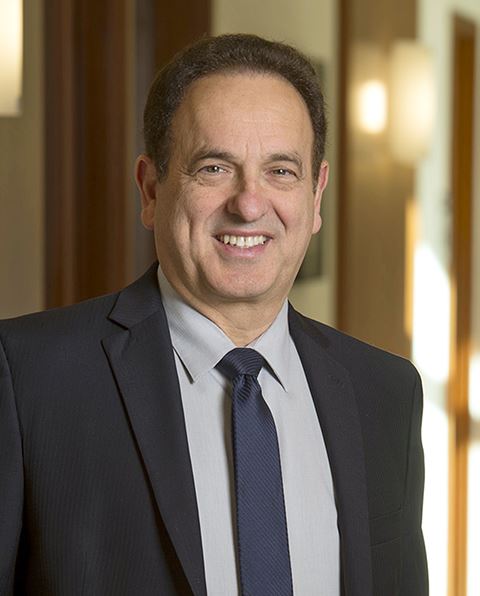“I see myself living a long and happy life."

Life could not have seemed better for Rebecca Swamy in 2015. The Freehold resident enjoyed her job as a special education teacher along with off-hours activities such as running, reading and spending time with her husband, Naveen. Around the holidays, the couple discovered that Swamy was pregnant with their first child.
But during that season of joy, her life took an abrupt turn. “I felt a funny bump at the top of my left breast,” Swamy says. Biopsies confirmed her worst fears: She was 32 and a mother-to-be—and had breast cancer. “It was scary because Naveen and I didn’t know what was going on,” she says. “We were overwhelmed.”

She turned to Robert Wood Johnson University Hospital (RWJUH) and Rutgers Cancer Institute of New Jersey, where her treatment was guided by Deborah Toppmeyer, MD, Chief Medical Officer and Director of the Stacy Goldstein Breast Cancer Center.
“Dr. Toppmeyer and her team made Naveen and me feel comfortable and safe,” Swamy says. “She told us about other pregnant patients and showed us pictures of their babies. I felt I was taken good care of from the moment I got there.”
A lumpectomy in her second trimester removed the tumor, and there was no sign the cancer had spread. What’s more, Swamy’s tumor type required no chemotherapy. “The next three months of my pregnancy were pretty normal,” she says. In September, she gave birth to a healthy baby boy, Shay.
Three days after delivering her baby, Swamy began eight weeks of radiation therapy to ensure the cancer would not return, along with hormone therapy to slow or stop the growth of any lingering cancer cells. Life soon settled into the new normal of parenthood.
A Second Shock
 At the end of 2019, Swamy and her husband were thinking ahead to her five-year cancer-free milestone. “We wanted to have another child,” she says.
At the end of 2019, Swamy and her husband were thinking ahead to her five-year cancer-free milestone. “We wanted to have another child,” she says.
But one morning, she felt an unusual bump in the center of her chest. Ultrasounds, a CT scan and other tests revealed that her breast cancer had spread to her sternum, or breastbone.
“Naveen and I were crushed,” she says. Trying for another child was now off the table as the couple wondered if she would even survive.

But the cancer treatment team at RWJUH and Rutgers Cancer Institute reassured Swamy that advanced treatment options were available. That’s when she was introduced to Bruce Haffty, MD, System Director of Radiation Oncology at RWJBarnabas Health, and Chair of Radiation Oncology and Associate Vice Chancellor for Cancer Programs at Rutgers Cancer Institute.
A key consideration was that the body’s tissues can only absorb a certain amount of radiation before becoming damaged. Areas surrounding Swamy’s tumor that had previously received radiation could be harmed by further treatment. But Dr. Haffty had a way around the problem: He would use a different form of radiation therapy called proton therapy.
Precise Delivery
Proton therapy delivers a beam of energy that can be more precisely targeted than X-rays used in traditional radiation therapy. “You can really focus the radiation and minimize overlap to previously radiated areas,” Dr. Haffty says.
Swamy’s proton therapy required just three visits. Sessions entailed lying on her back while machinery moved around her. “It seemed easier than traditional radiation,” she says. Aside from some redness in irradiated areas, she had few side effects.
At the one-year mark, Swamy underwent a CT scan and bone scan to assess the success of her advanced therapy. The news was fantastic. “There’s no active cancer in my bones,” she says.
Now 39, she remains a devoted educator and mother. “One of my fourth grade students did a breast cancer walk in my honor,” she says. “He wore a shirt that said, ‘I wear pink for my teacher.’” Swamy is likewise focused on the path forward. “I see myself living a long and happy life,” she says.
What Is Proton Therapy?
Proton therapy is a type of radiation therapy in which beams of energy destroy cancer cells. Different types of radiation can be used to individualize treatment based on a patient’s cancer and history.
Beams of traditional X-ray radiation are highly effective against cancer but mostly pass through tumors and exit the body, potentially exposing healthy cells and tissue along the way. Beams of proton radiation consist of tiny particles that largely stop inside the tumor.

This offers significant advantages to patients whose cancer recurs after earlier radiation therapy. Proton therapy can be precisely directed to spare previously irradiated normal tissue from further exposure and damage.
Recurrent breast cancer treatment is just one application, says Rahul Parikh, MD, Medical Director of the Laurie Proton Therapy Center at Robert Wood Johnson University Hospital. Proton therapy is also ideal for tumors near critical organs such as prostate cancer, pediatric brain cancers and head and neck cancer. “We can use it to treat just about any cancer from head to toe,” Dr. Parikh says.
Research into proton therapy’s benefits is ongoing. “Studies are still accruing,” Dr. Parikh says. “Over the next several years, we’ll have even more data on proton therapy’s uses and advantages.”
To learn more about proton therapy at Robert Wood Johnson University Hospital, call 732-253-3176.